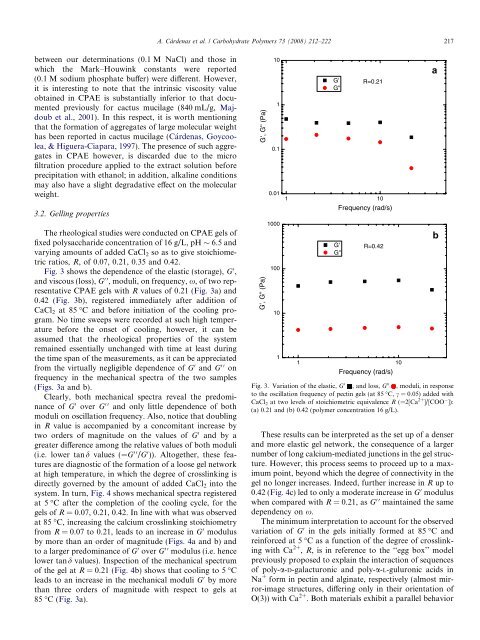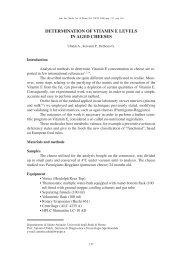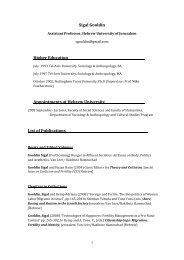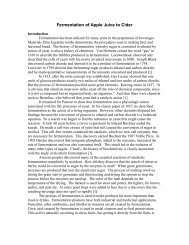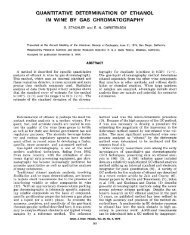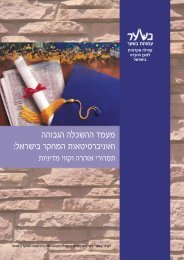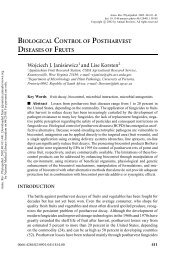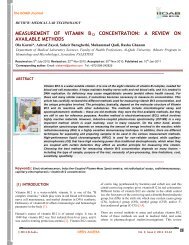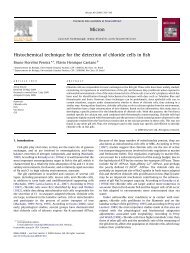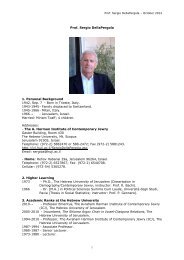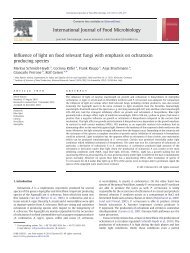On the gelling behaviour of 'nopal' (Opuntia ficus indica) low ...
On the gelling behaviour of 'nopal' (Opuntia ficus indica) low ...
On the gelling behaviour of 'nopal' (Opuntia ficus indica) low ...
You also want an ePaper? Increase the reach of your titles
YUMPU automatically turns print PDFs into web optimized ePapers that Google loves.
etween our determinations (0.1 M NaCl) and those in<br />
which <strong>the</strong> Mark–Houwink constants were reported<br />
(0.1 M sodium phosphate buffer) were different. However,<br />
it is interesting to note that <strong>the</strong> intrinsic viscosity value<br />
obtained in CPAE is substantially inferior to that documented<br />
previously for cactus mucilage (840 mL/g, Majdoub<br />
et al., 2001). In this respect, it is worth mentioning<br />
that <strong>the</strong> formation <strong>of</strong> aggregates <strong>of</strong> large molecular weight<br />
has been reported in cactus mucilage (Cárdenas, Goycoolea,<br />
& Higuera-Ciapara, 1997). The presence <strong>of</strong> such aggregates<br />
in CPAE however, is discarded due to <strong>the</strong> micro<br />
filtration procedure applied to <strong>the</strong> extract solution before<br />
precipitation with ethanol; in addition, alkaline conditions<br />
may also have a slight degradative effect on <strong>the</strong> molecular<br />
weight.<br />
3.2. Gelling properties<br />
The rheological studies were conducted on CPAE gels <strong>of</strong><br />
fixed polysaccharide concentration <strong>of</strong> 16 g/L, pH 6.5 and<br />
varying amounts <strong>of</strong> added CaCl2 so as to give stoichiometric<br />
ratios, R, <strong>of</strong> 0.07, 0.21, 0.35 and 0.42.<br />
Fig. 3 shows <strong>the</strong> dependence <strong>of</strong> <strong>the</strong> elastic (storage), G 0 ,<br />
and viscous (loss), G 00 , moduli, on frequency, x, <strong>of</strong> two representative<br />
CPAE gels with R values <strong>of</strong> 0.21 (Fig. 3a) and<br />
0.42 (Fig. 3b), registered immediately after addition <strong>of</strong><br />
CaCl2 at 85 °C and before initiation <strong>of</strong> <strong>the</strong> cooling program.<br />
No time sweeps were recorded at such high temperature<br />
before <strong>the</strong> onset <strong>of</strong> cooling, however, it can be<br />
assumed that <strong>the</strong> rheological properties <strong>of</strong> <strong>the</strong> system<br />
remained essentially unchanged with time at least during<br />
<strong>the</strong> time span <strong>of</strong> <strong>the</strong> measurements, as it can be appreciated<br />
from <strong>the</strong> virtually negligible dependence <strong>of</strong> G 0 and G 00 on<br />
frequency in <strong>the</strong> mechanical spectra <strong>of</strong> <strong>the</strong> two samples<br />
(Figs. 3a and b).<br />
Clearly, both mechanical spectra reveal <strong>the</strong> predominance<br />
<strong>of</strong> G 0 over G 00 and only little dependence <strong>of</strong> both<br />
moduli on oscillation frequency. Also, notice that doubling<br />
in R value is accompanied by a concomitant increase by<br />
two orders <strong>of</strong> magnitude on <strong>the</strong> values <strong>of</strong> G 0 and by a<br />
greater difference among <strong>the</strong> relative values <strong>of</strong> both moduli<br />
(i.e. <strong>low</strong>er tand values (=G 00 /G 0 )). Altoge<strong>the</strong>r, <strong>the</strong>se features<br />
are diagnostic <strong>of</strong> <strong>the</strong> formation <strong>of</strong> a loose gel network<br />
at high temperature, in which <strong>the</strong> degree <strong>of</strong> crosslinking is<br />
directly governed by <strong>the</strong> amount <strong>of</strong> added CaCl2 into <strong>the</strong><br />
system. In turn, Fig. 4 shows mechanical spectra registered<br />
at 5 °C after <strong>the</strong> completion <strong>of</strong> <strong>the</strong> cooling cycle, for <strong>the</strong><br />
gels <strong>of</strong> R = 0.07, 0.21, 0.42. In line with what was observed<br />
at 85 °C, increasing <strong>the</strong> calcium crosslinking stoichiometry<br />
from R = 0.07 to 0.21, leads to an increase in G 0 modulus<br />
by more than an order <strong>of</strong> magnitude (Figs. 4a and b) and<br />
to a larger predominance <strong>of</strong> G 0 over G 00 modulus (i.e. hence<br />
<strong>low</strong>er tand values). Inspection <strong>of</strong> <strong>the</strong> mechanical spectrum<br />
<strong>of</strong> <strong>the</strong> gel at R = 0.21 (Fig. 4b) shows that cooling to 5 °C<br />
leads to an increase in <strong>the</strong> mechanical moduli G 0 by more<br />
than three orders <strong>of</strong> magnitude with respect to gels at<br />
85 °C (Fig. 3a).<br />
A. Cárdenas et al. / Carbohydrate Polymers 73 (2008) 212–222 217<br />
G', G'' (Pa)<br />
G', G'' (Pa)<br />
10<br />
1<br />
0.1<br />
G'<br />
G''<br />
R=0.21<br />
0.01<br />
1 10<br />
Frequency (rad/s)<br />
1000<br />
100<br />
10<br />
1<br />
G'<br />
G''<br />
R=0.42<br />
1 10<br />
Frequency (rad/s)<br />
Fig. 3. Variation <strong>of</strong> <strong>the</strong> elastic, G 0 , and loss, G 00 , moduli, in response<br />
to <strong>the</strong> oscillation frequency <strong>of</strong> pectin gels (at 85 °C, c = 0.05) added with<br />
CaCl 2 at two levels <strong>of</strong> stoichiometric equivalence R (=2[Ca 2+ ]/[COO ]):<br />
(a) 0.21 and (b) 0.42 (polymer concentration 16 g/L).<br />
These results can be interpreted as <strong>the</strong> set up <strong>of</strong> a denser<br />
and more elastic gel network, <strong>the</strong> consequence <strong>of</strong> a larger<br />
number <strong>of</strong> long calcium-mediated junctions in <strong>the</strong> gel structure.<br />
However, this process seems to proceed up to a maximum<br />
point, beyond which <strong>the</strong> degree <strong>of</strong> connectivity in <strong>the</strong><br />
gel no longer increases. Indeed, fur<strong>the</strong>r increase in R up to<br />
0.42 (Fig. 4c) led to only a moderate increase in G 0 modulus<br />
when compared with R = 0.21, as G 00 maintained <strong>the</strong> same<br />
dependency on x.<br />
The minimum interpretation to account for <strong>the</strong> observed<br />
variation <strong>of</strong> G 0 in <strong>the</strong> gels initially formed at 85 °C and<br />
reinforced at 5 °C as a function <strong>of</strong> <strong>the</strong> degree <strong>of</strong> crosslinking<br />
with Ca 2+ , R, is in reference to <strong>the</strong> ‘‘egg box’’ model<br />
previously proposed to explain <strong>the</strong> interaction <strong>of</strong> sequences<br />
<strong>of</strong> poly-a-D-galacturonic and poly-a-L-guluronic acids in<br />
Na + form in pectin and alginate, respectively (almost mirror-image<br />
structures, differing only in <strong>the</strong>ir orientation <strong>of</strong><br />
O(3)) with Ca 2+ . Both materials exhibit a parallel behavior<br />
a<br />
b


